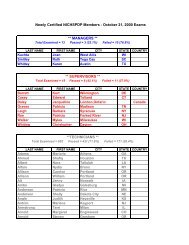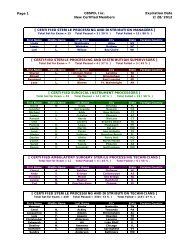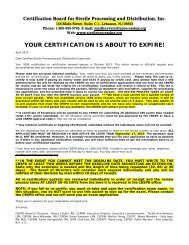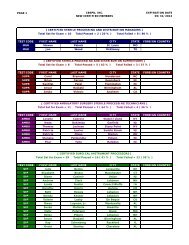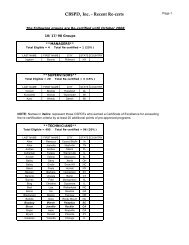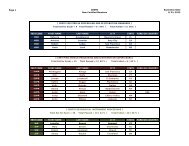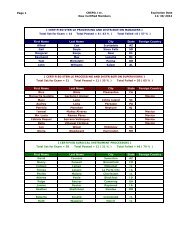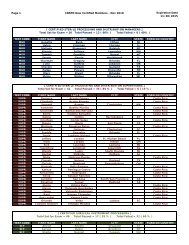Hospitals: Ethylene Oxide Sterilizers - US Environmental Protection ...
Hospitals: Ethylene Oxide Sterilizers - US Environmental Protection ...
Hospitals: Ethylene Oxide Sterilizers - US Environmental Protection ...
Create successful ePaper yourself
Turn your PDF publications into a flip-book with our unique Google optimized e-Paper software.
Federal Register / Vol. 72, No. 248 / Friday, December 28, 2007 / Rules and Regulations73621pwalker on PROD1PC71 with RULESon the information collectionrequirements in the 40 CFR part 63General Provisions (subpart A), some ofwhich are incorporated into the finalNESHAP. The ICR document includesthe burden estimates for all applicableGeneral Provisions. The recordkeepingand reporting requirements in theGeneral Provisions are mandatorypursuant to section 114 of the CAA (42U.S.C. 7414). All information submittedto EPA pursuant to the informationcollection requirements for which aclaim of confidentiality is made issafeguarded according to CAA section114(c) and the Agency’s implementingregulations at 40 CFR part 2, subpart B.The final NESHAP for area sourcesrequires a one-time initial notificationby hospital ethylene oxide sterilizationfacilities certifying that the facility is incompliance with rule requirements andrequires recordkeeping for eachsterilization cycle for sterilizers notequipped with an air pollution controldevice.The annual burden for theinformation collection averaged over thefirst 3 years of this ICR is estimated tototal 3,576 labor hours per year at a costof $245,000 for the 1,900 existinghospital sterilizer area sources. Smallannualized capital/startup costs andsmall operation and maintenance costsare associated with the requirements.No costs or burden hours are estimatedfor new area sources because no newsources are estimated during the next 3years. Burden means the total time,effort, or financial resources expendedby persons to generate, maintain, retain,or disclose or provide information to orfor a Federal agency. This includes thetime needed to review instructions;develop, acquire, install, and utilizetechnology and systems for the purposesof collecting, validating, and verifyinginformation, processing andmaintaining information, and disclosingand providing information; adjust theexisting ways to comply with anypreviously applicable instructions andrequirements; train personnel to be ableto respond to a collection ofinformation; search data sources;complete and review the collection ofinformation; and transmit or otherwisedisclose the information.An agency may not conduct orsponsor, and a person is not required torespond to a collection of informationunless it displays a currently valid OMBcontrol number. The OMB controlnumbers for EPA’s regulations in 40CFR are listed in 40 CFR part 9. Whenthis ICR is approved by OMB, theAgency will publish a technicalamendment to 40 CFR part 9 in theFederal Register to display the OMBcontrol number for the approvedinformation collection requirementscontained in this final rule.C. Regulatory Flexibility ActThe Regulatory Flexibility Act (RFA)generally requires an agency to preparea regulatory flexibility analysis of anyrule subject to notice and commentrulemaking requirements under theAdministrative Procedure Act or anyother statute unless the agency certifiesthat the rule would not have asignificant economic impact on asubstantial number of small entities.Small entities include small businesses,small organizations, and smallgovernmental jurisdictions.For the purposes of assessing theimpacts of the area source NESHAP onsmall entities, small entity is defined as:(1) A small business that is a hospital asdefined by NAICS codes 622110 and622310 whose parent company has lessthan $31.5 million in gross revenue(based on Small BusinessAdministration (SBA) size standards);(2) a small governmental jurisdictionthat is a government of a city, county,town, school district, or special districtwith a population of less than 50,000;and (3) a small organization that is anynot-for-profit enterprise which isindependently owned and operated andis not dominant in its field.After considering the economicimpacts of this final rule on smallentities, I certify that this action will nothave a significant economic impact ona substantial number of small entities.The final rule requires the use of amanagement practice to minimize theoperation of the ethylene oxidesterilization unit and will, therefore,have minimal nationwide costs, i.e.,range from $32,000 to $61,000 per year.We have determined that less than 3percent of the hospitals are smallbusinesses as defined by the SBA. Wehave also determined that none of thesesmall businesses are significantlyimpacted by this proposal for none ofthem will incur annualized compliancecosts of 0.1 percent of sales or greater.Although this final rule will not havea significant economic impact on asubstantial number of small entities,EPA nonetheless has tried to reduce theimpact of this rule on small entities. Thefinal rule is designed to harmonize withexisting State or local requirements.D. Unfunded Mandates Reform ActTitle II of the Unfunded MandatesReform Act of 1995 (UMRA), PublicLaw 104–4, establishes requirements forFederal agencies to assess the effects oftheir regulatory actions on State, local,and tribal governments and the privateVerDate Aug2005 23:53 Dec 27, 2007 Jkt 214001 PO 00000 Frm 00049 Fmt 4700 Sfmt 4700 E:\FR\FM\28DER1.SGM 28DER1sector. Under section 202 of the UMRA,EPA generally must prepare a writtenstatement, including a cost-benefitanalysis, for proposed and final ruleswith ‘‘Federal mandates’’ that mayresult in expenditures to State, local,and tribal governments, in the aggregate,or to the private sector, of $100 millionor more in any one year. Beforepromulgating an EPA rule for which awritten statement is needed, section 205of the UMRA generally requires EPA toidentify and consider a reasonablenumber of regulatory alternatives andadopt the least costly, most costeffective,or least burdensomealternative that achieves the objectivesof the rule. The provisions of section205 do not apply when they areinconsistent with applicable law.Moreover, section 205 allows EPA toadopt an alternative other than the leastcostly, most cost-effective, or leastburdensome alternative if theAdministrator publishes with the finalrule an explanation why that alternativewas not adopted. Before EPA establishesany regulatory requirements that maysignificantly or uniquely affect smallgovernments, including tribalgovernments, it must have developedunder section 203 of the UMRA a smallgovernment agency plan. The plan mustprovide for notifying potentiallyaffected small governments, enablingofficials of affected small governmentsto have meaningful and timely input inthe development of EPA regulatoryproposals with significant Federalintergovernmental mandates, andinforming, educating, and advisingsmall governments on compliance withthe regulatory requirements.EPA has determined that the final ruledoes not contain a Federal mandate thatmay result in expenditures of $100million or more for State, local, andtribal governments, in the aggregate, orthe private sector in any one year. Thus,the final rule is not subject to therequirements of sections 202 and 205 ofthe UMRA. In addition, the final ruledoes not significantly or uniquely affectsmall governments. The final rulecontains no requirements that apply tosuch governments, impose noobligations upon them, and will notresult in expenditures by them of $100million or more in any one year or anydisproportionate impacts on them.Therefore, the final rule is not subject tosection 203 of the UMRA.E. Executive Order 13132: FederalismExecutive Order 13132, entitled‘‘Federalism’’ (64 FR 43255, August 10,1999) requires EPA to develop anaccountable process to ensure‘‘meaningful and timely input by State



